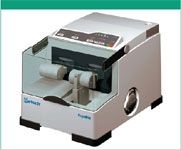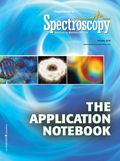Preparation of Polymers for XRF
It is shown that the Retsch CryoMill polymers are ground to a significantly smaller fineness compared to other methods. Especially for inhomogeneous materials, small particles are the key for a high reproducibility.
It is shown that the Retsch CryoMill polymers are ground to a significantly smaller fineness compared to other methods. Especially for inhomogeneous materials, small particles are the key for a high reproducibility.

Introduction
For many analytical problems in the field of polymer industry XRF (X-Ray Fluorescence) is a very efficient multi element-method for the determination of heavy metals in plastic parts or granulates. In a modern laboratory additionally to the accuracy and reproducibility of the results time security of the laboratory employees are crucial Factors. This is the reason why for more and more applications XRF is preferred because ICP and AAS need time-consuming digestion with strong acids.
In XRF polymers are analysed as powders. To get reliable results, the powder particles should be at least around 500 μm. Smaller particle sizes are advantageous because less disturbing reflections are detected and the material is more homogenous.
Results
For the grinding experiment 3 different mills were used: the Retsch CryoMill, the Retsch MM 400 with CryoKit, and a standard mill for cryo grinding. The sample was a piece of a commercial car tyre. With the MM 400 the sample was pre-cooled in a bath filled with liquid nitrogen (CryoKit) and ground at room temperature. Figure 1 shows the results for the 3 different mills. It can be clearly seen that the result for the MM 400 with CryoKit and the standard cryogenic mill are almost identical. With the Retsch CryoMill a significantly higher fineness can be achieved (>20% better).

Figure 1
In a second experiment the filling of a car seat was ground. Traditionally this is done with a cutting mill, but it is very hard to get particles smaller than 1 mm, because the material gets too hot in the cutting process. For applications like this the CryoMill is very effective — sizes down to 200 μm are easily possible.
Conclusion
For many materials cryogenic grinding is the only method to produce particle sizes below 500 μm which are necessary to obtain reliable results in XRF. The Retsch CryoMill is a perfect tool for grinding polymers which are above the glass point at room temperature. For XRF, grind sizes are obtainable which are significantly lower compared to other mills. Especially for challenging materials like car tyres or fibres the Retsch CryoMill is a perfect tool for XRF sample preparation. Since the Retsch CryoMill works with a liquid nitrogen cycle, the system is both safe and convenient to use.

Retsch GmbH
Rheinische Strasse 36
42781 Haan, Germany
Tel +49 2129 5561-0, Fax +49 2129 8702

The World of Microplastics Up to Date – an Overview
April 23rd 2024Watch this 20-minute educational video by Andreas Kerstan, Agilent Product Specialist in molecular spectroscopy, to gain a comprehensive update on the microplastics landscape and the environmental concerns related to them. Discover the current challenges in microplastics characterization and how Agilent innovative solutions and techniques, including FTIR, LDIR, GC/MS, and ICP-MS, are addressing these issues head-on.
Accurate Microplastics Analysis in Minutes, Not Hours
April 10th 2024The automated Agilent 8700 LDIR chemical imaging system lets you obtain high-quality images and spectral data faster than ever before. So, you can perform confident large-scale microplastics studies and monitoring activities.